Tessellation Patterns - From Mathematics to Art
Do you know what is the definition of tessellation and what does it take to create one? When a geometric shape is repeated over and over again, covering a plane of tiles without any gaps or overlaps, it results in a tessellation - a mosaic pattern of a mesmerizing visual effect. Although it derives from a clear set of rules based on mathematical shapes and calculations - a fact which might give out the impression that there is no space for creativity - tessellations have been widely accepted in a great number of cultures, and are employed in many spheres of life such as design and art.
Also known as tiling, the process of creating a tessellation can be based on a regular, semiregular geometric or non-geometric shape or tile, which are then all lined up next to each other as basic elements checkered to assemble larger complex construction. In fact, the very word “tessellation” comes from Latin tessellātus, meaning “of small square stones” made of stone, clay or glass, and from Greek τέσσερα - tessera, meaning “four”, both alluding to the fact that the first tilings were made from square tiles, as the easiest shapes from which to create a pattern.

A Brief History of Tessellations
Because of their characteristics and decorative aesthetics, tessellations were used in art and architecture alike, providing coverings for walls, pavements and ceilings of many facilities. Origin of tessellation can be traced back to 4,000 years BC, when the Sumerians used clay tiles to compose decoration features in their homes and temples. From there, tessellation found its place in the art of many civilizations, from the Egyptians, Persians, Romans and Greeks to the Byzantines, Arabs, the Japanese, Chinese and the Moors. Of course, the nature and design of tiling varied, as they evolved and adapted to match each of these cultures and traditions. During the Middle Ages through the 19th century, a group of intellectuals began observing tessellation present in nature in order to explain its geometric structures, which resulted in numerous studies based on mathematics. Today, we can talk about tessellation art of the great M.C. Escher and a number of contemporary artists who are using the concepts of tiling to create artworks in a variety of media.
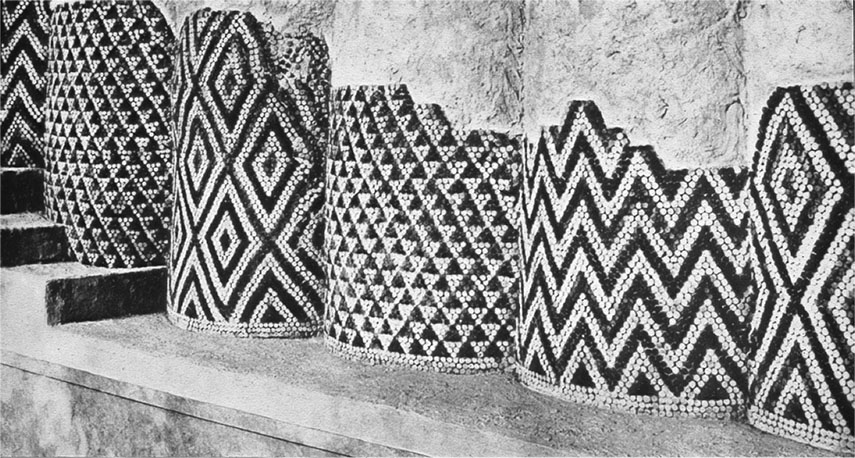
Tessellation In Islamic Art and Architecture
Perhaps the most interesting examples of tessellation technique can be found in Islamic art and architecture, in particular of the Muslim inhabitants of the Maghreb, North Africa, the Iberian Peninsula, Sicily and Malta during the Middle Ages. The concept of coloured geometric shapes fit in perfectly, as Islam forbids the living object as a representation in art, so they embraced the abstract characteristics of a tessellation in a spectacular manner. Apart from the Alhambra palace, geometric patterns and tiling were used in decorative arts as well, like textiles and pottery. These designs are often termed “zillij” or “zellige”, which is an art with a foundation in “learning, discipline and faith.” Based on the Islam teachings that life is based on universal intelligence, zillij artists depicted the laws that govern the universe, using terra cotta tiles covered with enamel. Traces of zillij tessellation art can still be found in Morocco and Algeria, on the walls and floors of homes, mosques, public water fountains, tombs etc.
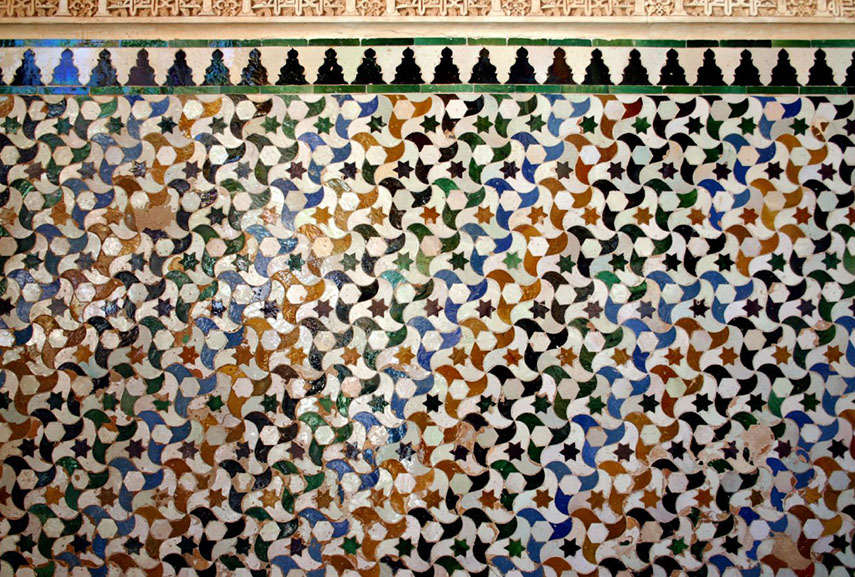
The Mathematics of Tessellation
Tessellation patterns have been widely used in art and architecture since ancient times, but what lies under it is mathematics. Tessellation theory is extensive and complex, but we will explain some basics in order to bring you closer to what is behind these beautiful works of art. When it comes to tessellation in mathematics, also known as tiling, it is necessary to explain several technical terms that geometry operates with. A fundamental region is a shape that is repeated in order to form a tessellation. It is also called the tile. An edge is an intersection between two bordering tiles that is often a straight line. A vertex is the point of intersection of three or more bordering tiles. A polygon is a plane figure with at least three straight sides and angles, and typically five or more. With some of the basic terminology explained, let’s delve into the math world of tessellations.
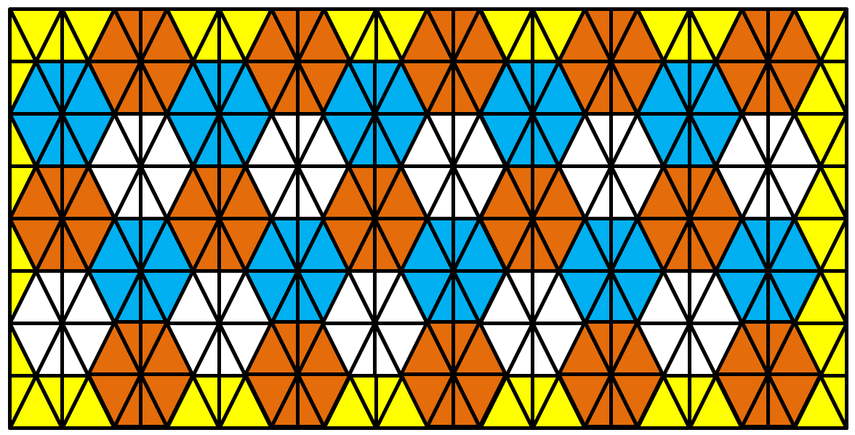
Tessellation Patterns : The Basic Classification
One shape of a tile in a tessellation is called a prototile. In terms of the number of prototiles used, the tiling that has only one prototile is named monohedral tiling. This type of tiling is composed of a single shape, meaning that all tiles used are congruent to one another. At first, you might think that this type of tiling is simple and rather boring, but it is definitely not so. A particularly interesting type of monohedral tiling is the spiral monohedral tiling that was first discovered by Heinz Voderberg in 1936. The tiling can also be dihedral. In this case, every tile is congruent to one or the other of two distinct prototiles, meaning that the tiling is composed of two different shapes. Similarly, there are trihedral, tetrahedral or n-hedral tilings that signify the involvement of three, four or 'n' prototiles.
Based on the types of polygons, tessellations are classified as regular, semi-regular and non-regular or irregular. A highly symmetric one, a regular tessellation is made up of regular polygons that are all of the same shape and all meeting vertex to vertex. A regular polygon is one where all the sides and angles are equivalent. There are only three regular tessellations and they are made of a network of equilateral triangles, squares and hexagons. The sum of the angles of polygons in a regular tessellation forms 360 degrees around each vortex. A semi-regular tessellation is made of two or more types of regular polygons. These regular polygons are arranged in a way that every vertex point is identical, meaning that each vertex is surrounded by the same polygons arranged in the same cyclic order. There are eight semi-regular tessellations which comprise different combinations of equilateral triangles, squares, hexagons, octagons and dodecagons. Non-regular tessellation is the one in which there are no restrictions regarding the shapes used or their arrangement around vertices. It is believed there is an infinite number of irregular ones.

The Symmetry and Wallpaper Groups
When observing a completed tessellation, you could notice that the original tile, or a motif, repeats in a pattern. One mathematical idea that can be emphasized through tessellations is symmetry. Yet, a line symmetry that could be found when two halves of a certain figure are congruent should not be confused with the type of symmetries that could be found in the plane of a tessellation. In terms of an infinite plane, these symmetries are referred to as plane symmetries or geometric transformations. There are three types of symmetry in a plane that move the motif in a way that it still matches the original one exactly: the translational one, the rotational one and a glide reflection. A translational symmetry is a result of moving a figure a certain distance in a certain direction. These tessellation patterns could also be rotated around a certain point with a certain angle of rotation and that is called a rotational symmetry. A glide reflection involves the reflection of a motif across a mirror line and its translation. It is the only type that involves two steps. These three types of symmetry are called isometric, meaning that tiles don't change size. But, there are also patterns consisted of tiles gradually getting smaller or larger in an expanding circle. Many mathematicians wouldn't call these tessellations since the tiles are not of the same size and could not entirely fill a plane in the centermost point.
Tessellations can be made with different combinations of transformations. There are actually 17 possible ways that a pattern can be used to tile a flat surface. These are called wallpaper groups and it is a mathematical classification based on the symmetries in the two-dimensional motif. The proof about the number of possible tessellation figures was first carried out by Evgraf Fedorov in 1891 and it was derived independently by the mathematician George Pólya in 1924. Pólya’s paper inspired Escher who, even though not understanding the abstract concept of the groups discussed, understood these 17 symmetry groups and later on produced 43 drawings based on them. It is believed that the Alhambra palace in Granada contained examples of all 17 groups.

The Periodic and Aperiodic Tiling
Tessellations may be further classified according to how unit cells containing one or more tiles are arranged. If the unit cells are arranged such that a regular repeating pattern is produced, the tessellation is termed periodic. Periodic tessellations repeat the tile or a motif in two separate directions forever and they form motifs with symmetry given by one of the seventeen wallpaper groups. If the arrangement produces an irregular or random pattern, the tessellation is then termed aperiodic. These tessellations have no translation symmetry and the pattern cannot be repeated periodically only covering a portion of the plane. Some of the best-known examples of aperiodic tessellation patterns are Penrose tilings that employ two different quadrilaterals or Pinwheel tilings where tiles appear in infinitely many orientations. Even though aperiodic tessellations look random, they do have rules that generate them such as the substitution rule or a Fibonacci word. Another type of aperiodic tessellations are Wang tiles consisted of squares coloured on each edge and placed in a way that abutting edges of adjacent tiles have the same colour. Sometimes called Wang dominoes, these tessellation patterns can tile a plane, but only aperiodically.
When considering the use of colour in tessellation technique, it needs to be specified whether colours are part of the tiling or just part of its illustration added randomly. This is important in terms of understanding whether tiles of the same shape but different colours are considered identical or not. This is an issue that consequently affects the symmetry of the tiling.
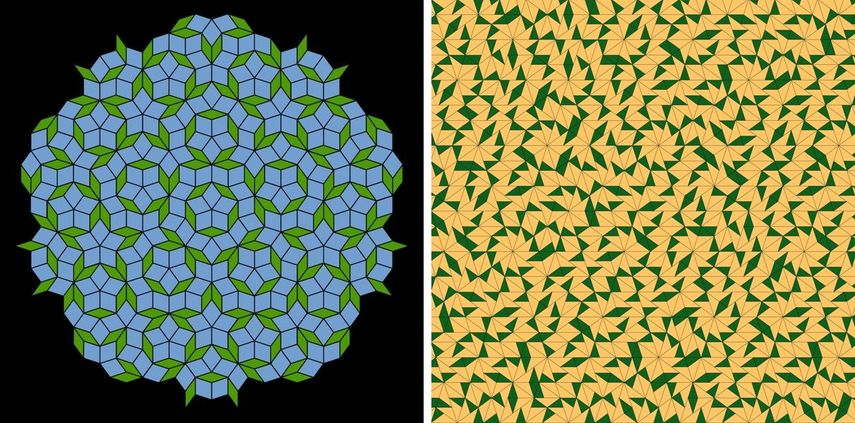
What About the Tessellations in Higher Dimensions?
We have so far covered tessellations on a two-dimensional plane, but can tessellation motifs be three-dimensional? Certain polyhedra, or solids in three dimensions with flat polygonal faces, straight edges and sharp corners, can be piled in a regular crystal pattern to fill a three-dimensional space. These more-dimensional templates are named honeycombs. There is a significant potential to integrate periodic and aperiodic tessellation designs in architecture. With the advancement of computer programming, it is possible to generate higher-dimensional tessellations that could be useful in various architectural applications.

Tessellations In Non-Euclidean Geometries
So far, we have been considering only tessellations within the Euclidean geometry. Euclidean space encompasses the two-dimensional Euclidean plane, the three-dimensional space of Euclidean geometry and certain other spaces. These spaces are distinguished from two other types of spaces that belong to non-Euclidean geometry - hyperbolic and spherical. The essential difference between Euclidean geometry and these two other ones is the nature of parallel lines. While in Euclidean geometry, given a point and a line, there is exactly one line through the point that is in the same plane as the given line and never intersects it, in hyperbolic geometry there are at least two distinct lines that pass through the point and are parallel to the given line and in spherical geometry there are no such lines at all. So is it possible to tessellate in non-Euclidean geometries? It is possible in the hyperbolic geometry. While in a Euclidean plane there are three regular tessellations, the number of regular ones in a hyperbolical plane is infinite. When it comes to semi-regular ones, there are also much more combinations that in Euclidean plane. They are also possible in the three-dimensional hyperbolic space.
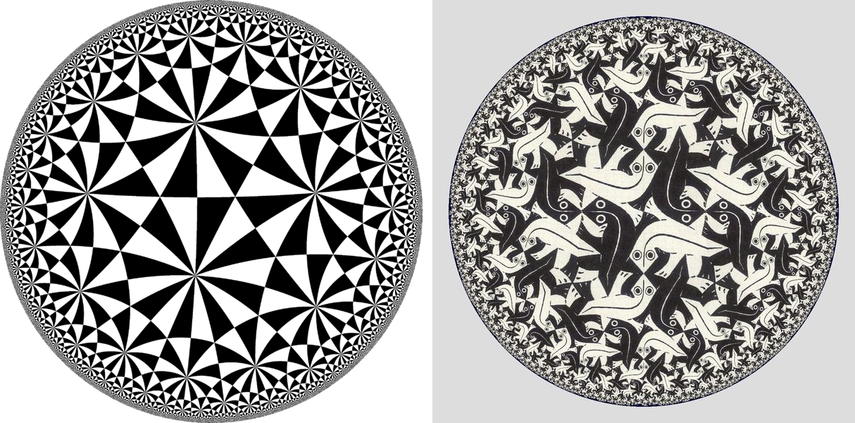
Tessellation Patterns in Puzzles and Recreational Mathematics
Apart from the world of art and architecture, tessellation designs could be found in many types of tiling puzzles, from traditional jigsaw puzzles and tangram to more modern puzzles based on mathematics. Combining art and math, the majority of tessellation puzzles can be assembled in several different ways, making them open-ended and encouraging creativity. When it comes to recreational mathematics, authors such as Henry Dudney and Martin Gardner have made many uses of tessellations in this field. Famous for his puzzles and mathematical games, Dudney invented the hinged dissection puzzle - a geometric dissection in which all of the pieces are connected into a chain by 'hinged' points, such that the rearrangement from one figure to another can be carried out by swinging the chain continuously without severing any of the connections. A mathematician and author in the magazine Scientific American, Gardner frequently wrote about rep-tiles, shapes that can be dissected into smaller copies of the same shape. His articles in the Scientific American have inspired many mathematicians interested in tessellations. One of them was Robert Reid who covered diverse areas of recreational mathematics including tessellation, geometry dissection, number theory, 'squares in squares' and more. Another mathematician inspired by Gardner's articles was Marjorie Rice who despite having only a high-school education discovered four new tessellations with pentagons. One of the most popular tessellation problems in recreational mathematics is the so-called 'squaring the square', a tiling an integral square using only other integral squares. The task can go from an easy one to extremely complex one based on conditions and restrictions set.

Tessellation in Art
The connection between science, mathematics and art is an inevitable thing we need to mention if we wish to comment about various examples of tessellations in art, crafts, and architecture. Mathematicians, scientists, and artists govern their practices to help us better understand the world around us and reflect upon questions that direct our existence. The division between the intuition and hard, cold logic that most of us tend to think about if we think about art and science is often blurred and many artists have focused their artistic production following certain scientific and mathematical rules. The golden ratio in art is just one of various tools artists used to produce images that reflect the mysteries of the natural world or to produce the most pleasing image for the eye, and none of us can overlook the repetition, geometrical shapes, symmetry in some of the most celebrated works of art history or contemporary pieces today.
The most renowned tessellation artist in history, presently still very much adored by mathematicians and the rest, whose production focused on the questions concerning the nature of visual perception, infinity, and patterns is M.C. Escher. His use of tessellations in art pieces, the practice of using regular patterns that divide the plane, without his knowledge in mathematics and its principles beyond secondary school, fascinates still today.
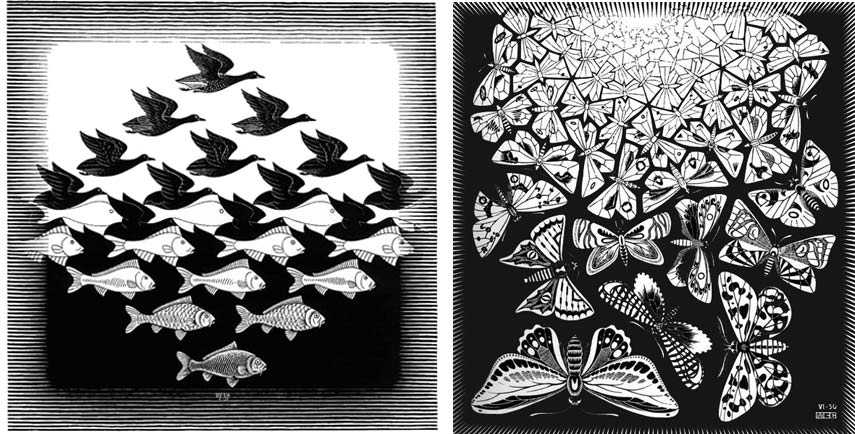
M. C. Escher and Tessellation Art
The 20th-century artist Maurits Cornelis Escher created some of the most memorable woodcuts, lithographs, mezzotints, and drawings inspired by the fictional investigation into the formal possibilities of perspective and the tiling of a plane using one or more geometrical shapes. His most famous quotes “ We adore chaos because we love to produce order “ and “ I believe that producing pictures, as I do, is almost solely a question of wanting so very much to do it well ” explain the passion he felt for balance, harmony, and perfection. His enormous production received recognition almost immediately by scientists and mathematicians, and the global art fame reached him when he was considered a pioneer of the psychedelic and trippy art of the hippy counterculture of the 1960’s. Yet, Escher felt that his art belongs to no movement, not even to Op Art or Illusion Art that almost all of us think about when we hear the artist’s name.
The defining moment that pushed the artist towards the creation of the art we most associate with his name was his trip to Granada, Spain and his visit to the Alhambra Palace. There, M. C. Escher carefully copied some of the geometrical tilings that covered the façade of the palace and from that moment, his production became less observational and more formally inventive. The exploration of patterns and the regular division of planes was the richest inspiration that the artist ever faced.
His most celebrated pieces following the principles of tessellation explored the basic patterns, but the artist elaborated further, distorting the shapes and rendered them into animals, birds, and other figures. His elaborate interlocking designs relayed heavily on his love for the natural world that helped him to construct hexagonal grids moving far beyond the human world and into more of a phantasmagoric world of strange creatures that resemble lizards, insects, fish, and birds. Arranging his shapes across a flat plane in such a way that the spaces between them make other recognizable shapes is evident in most of Escher’s tessellations out of which the most notable ones are black and white images. In many of these images, the distinction between foreground and background is obliterated and the viewer can choose to see one or other set of shapes as foreground at will. The distortions which the artist produced obeyed the three, four, or six-fold symmetry of the underlying pattern and the effects were both startling and beautiful and in keeping with the tessellation rules.
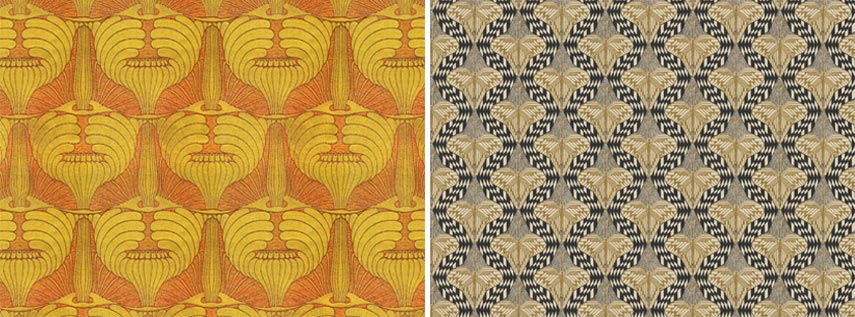
Tessellation Patterns of Koloman Moser
The mathematical trickery that plays with the eye’s perception stood at the core of Op Art was also put to use for a more decorative purpose by various art and crafts artists that focused their production on tapestry and textile design, along with the production of elaborate embellishments on pottery works. The famous pattern designs that follow the principles of tessellation of one of the most decorative avant-garde movement Art Nouveau form the design production of Koloman Moser. As one of the founders of the Vienna Secession, Moser, like Escher was a master of tessellation. Unlike the painter, he put his creative forces and investigation of pattern design into something more ‘practical’ and helped to shape the world of fashion design, since his textile patterns are some of the most exquisite examples that look quite modern even today. Following with the love of spiral line, flowers, buds, leaves and geometrical shapes, his elaborate designs transcended onto a variety of works such as tapestry design, posters, furniture, tableware, jewelry, postage stamps etc. The play with reflection and repeat of certain motifs, along with the joining of different images like flowers, foliage, and birds, in different combinations across the reflection axes is known today as drop design. This kind of design was the most common way for 19th-century designers to compose wallpaper symmetry designs, and we see much of this in Moser’s work as well.
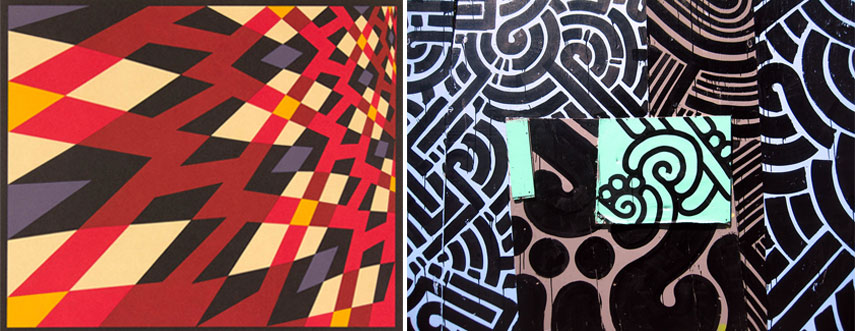
Tessellations in Contemporary Art
The digital age and the computer dominance have greatly influenced the world of contemporary art. Moving away from graphic artworks by Escher, or prints by the leading Swiss Constructive artist Hans Hinterreiter that are also famous examples of the principle, today the computer generated tessellation patterns are easy to come by. The meshing of the images follows the principle that is also used to shape the images we see on our screens. The world of graphic art today is a vast area of beautiful examples of how art fuses with mathematics and science, and how a repetition of patterns is put to use.
This repetition of patterns also makes up a rich history of mosaic and mural paintings. From Ancient Greece to Roman Art, Byzantine and elaborate examples of Mexican mural and mosaic paintings, today we witness mosaics, murals, and graffiti art all over the world that are modern day examples of this old principle as well.
Tessellations In Nature, Artworks and Architecture
Although the exactly repeating tilings are more than convenient for art and design at large, they are harder to find in nature. One of the most famous examples of tessellations sure is honeycomb and its hexagonal wax cells, as well as a few species of flowers, such as Fritillary. In landscape, a tessellated pavement can be found on the Tasman Peninsula of Tasmania, and it represents a rare sedimentary rock formation where the rock has fractured into rectangular blocks. Apart from these few well-known natural patterns, a much more frequent sight are the man-made structures and also artworks, inspired by the simplicity in complexity of tessellations. Today, we can talk about famous architectural landmarks that employ exquisite patterns; think the Pyramid of The Louvre, London’s Swiss Re Building and the ceiling of the British Museum, Melbourne’s Federation Square and the details on the façades of Hagia Sophia in Istanbul and the Taj Mahal in Agra. But as we mentioned earlier, tessellations became a great source of inspiration for the Islamic architecture of the Moors, and some of the most remarkable patterned structures can still be visited across North Africa and beyond. When it comes to art, it all begins with the intrinsic works of MC Escher and a number of other artists who have embraced the art of tiling in order to deliver visually stunning pieces.

The Alhambra
Constructed by the Muslim Moors in the 14th century, the Alhambra stands tall as one of the most glorious fortressed-turned-palaces carrying the tessellation patterns. Located on a hill close to the Darra River in Granada, Spain, this “red” complex was originally designed as a military base, which was then turned into the home of King Mohammed ibn Yusuf ben Nasr. Today, it is listed as a UNESCO World Heritage site and its colored tiles in symmetrical and even geometrical patterns are still as mesmerizing as ever, as they are mixed with a rich arabesque setting. Famously, the tessellations of Alhambra inspired the young MC Escher, who copied these geometric patterns into his notebooks and later tweaked some of them into designs that resembled animals or people.
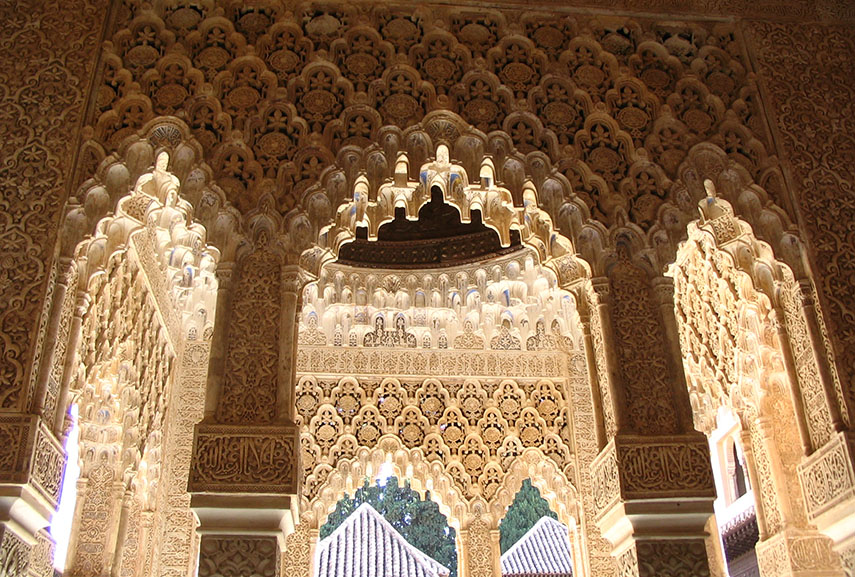
The Moroccan Court at The Met
As of 2011, the visitors of New York’s Metropolitan Museum of Art can enjoy an impressive collection of Islamic art. In order to house it, the institution had to build a special courtyard gallery, now known as The Moroccan Court. They invited an entire team of marvellous craftsmen, curators, historians and designers from Morocco to build a structure that both recalls history and evokes the future, thus oozing with tradition and modernity alike. Over the course of many months, The Moroccan Court are to become a new home for the Art of the Arab Lands, Turkey, Iran, Central Asia and Later South Asia. In the manner of the greatest masters of their craft, these man delicately created superb tessellations using a variety of materials, and covered surfaces like the floor, the ceiling, the columns and the walls with impressive precision.
The Arab Hall at the Leighton House Museum
In 1877, Lord Leighton began the construction of the Arab Hall inside his Leighton House Museum in London. This ambitious and costly undertaking was inspired by his travels to Turkey, Egypt and Syria - in fact, it is the collection of tiles from Damascus that makes up the biggest part of this great room. Its model was based on an interior inside a 12th century Sicilia-Norman palace named La Zisa in Palermo, Sicily, and the construction was executed by a group of potters, sculptors and artists. The mosaics and marbles and skilled craftsmen were all sourced in London, although the design for the gold mosaic frieze by artworker Walter Crane was made up in Venice and shipped to the site in sections. The Arab Hall houses an incredible collection of Middle Eastern glazed tiles, which dates from the end of the 15th and the beginning of the 16th century. It stands as one of the most important collections of its kind in the UK.

Koloman Moser’s Art Nouveau Tessellations
One of the founders of the Vienna Secession in 1897, Koloman Moser was an artist working many fields and media, such as painting, printmaking, design, drawing and, in particular, fabric design. It is, in fact, with the fabrics that he started exploring the possibilities of creating a tessellation, which feature patterns featuring fish, sirens, birds, plants and flowers, mainly created between 1899 and 1903. One of his most common topics were fish, which he developed to fit each other perfectly within a pattern. These artworks were often also accompanied by typical Art Nouveau figures of the female nude and as they depicted ornaments in their core, they were also considered significant artworks of this visually rich movement. Furthermore, Koloman Moser also designed the glass tessellation of the windows of the Church on the “Steinhof” in Vienna.
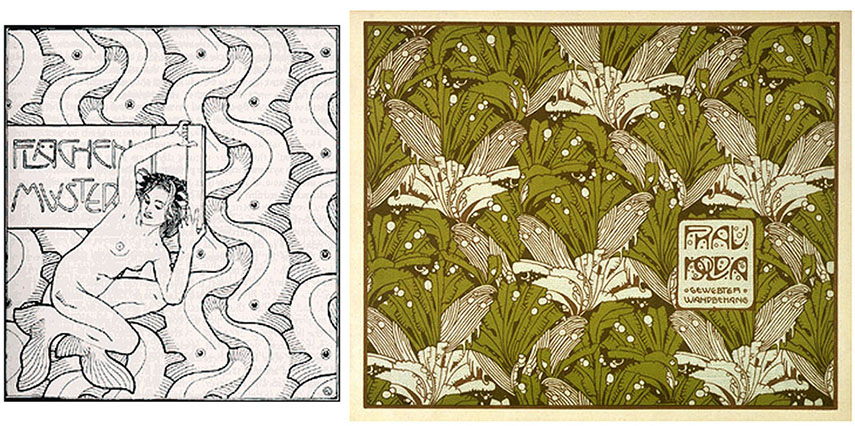
M.C. Escher - Reptiles, 1943
At one point in his career, M.C. Escher became obsessed with filling surfaces to the point where there are no gaps or overlaps whatsoever. ”Filling two-dimensional planes has become a real mania to which I have become addicted and from which I sometimes find it hard to tear myself away,” he famously said, as he brilliantly mixed drawing with tessellation patterns. In this 1943 lithograph print, entitled Reptiles, we see yet another masterfully executed artwork which depicts a kind of a cycle in which a number of reptiles perpetually becomes alive and a part of a tessellation on a desk with books, plants, a bottle of a drink etc. A great fan of paradox, M.C. Escher included a tessellation in an otherwise “regular” composition, mixing two-dimensionality with objects in space in a way no one has ever done it before him and perfectly describing the complex relationship between the two concepts of space.
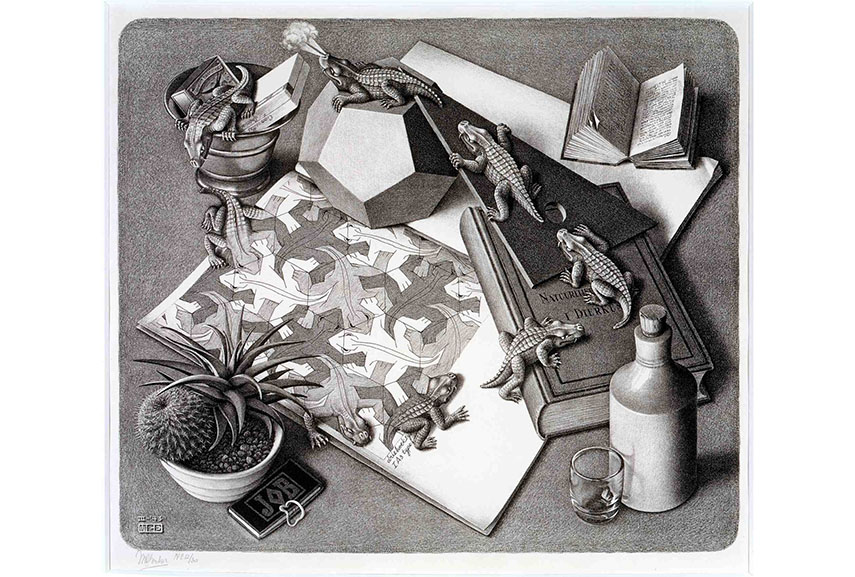
Hans Hinterreiter’s Studies
The work of Hans Hinterreiter is often described as “abstract” and “optical”, probably because of his fascination with tessellation and the way shapes can be joined to compose endless patterns of color and dynamic compositions. He worked with acrylic canvases, temperas, drawings and prints, all of which exude a certain sense of perfection, in which color, in fact, has an important role in conveying the smooth flow of the surface. Hans Hinterreiter’s forms are harmonious, satisfyingly orderly, deprived of any realistic scenario or an apparent message. His art, in a way, evokes a kind of a music composition, almost in the manner of one Piet Mondrian and his Broadway Boogie Woogie, as the pieces stand still in time, yet appear as though they are about to start twirling, ebbing and flowing any minute now.

Make Your Own Designs that Tessellate!
If you’re interested in the concept of shapes and patterns repeating to infinity, you don’t have to be a math genius or even a graphic designer to make your own tessellation art. For instance, you can be handy and use a flat surface like paper, in order to produce slide symmetry as complex as you want it to be. This way, you get to play with sizes, positions and orientations of your shapes under informal transformations such as flips, turns, slides and scaling, and employ a variety of tools, techniques and formulas in order to achieve precision and perfection. If you still don’t feel ready for that, you can always use a generator, like Illuminations or Shodor, or consult numerous tutorial videos online that explain the technique in a simple and easy manner. Of course, you can always just enjoy the artwork and architecture inspired by tessellate shapes. Who could have known that maths could be fun?
Editors’ Tip: Origami Tessellations: Awe-Inspiring Geometric Designs
Origami Tessellations: Awe-Inspiring Geometric Designs is the only manual on creating your own project that you will ever need! Eric Gjerde demonstrates 25 of his favorite tessellating designs and turns them into projects for newcomers as well as experienced origamists. With step-by-step instructions, illustrated crease patterns, and how-to photos, you'll learn to create these wonderful designs yourself. Eric's first book covers the fundamentals of origami tessellations, provides history, and describes simple beginning techniques with detailed illustrations and photographs. An extensive gallery showcases these forms folded by the world's leading origami fine artists---inspiring you to experiment, innovate, and eventually create your own unique designs.
Featured images in slider: Artwork by MC Escher. All images used for illustrative purposes only.
Can We Help?
Have a question or a technical issue? Want to learn more about our services to art dealers? Let us know and you'll hear from us within the next 24 hours.

